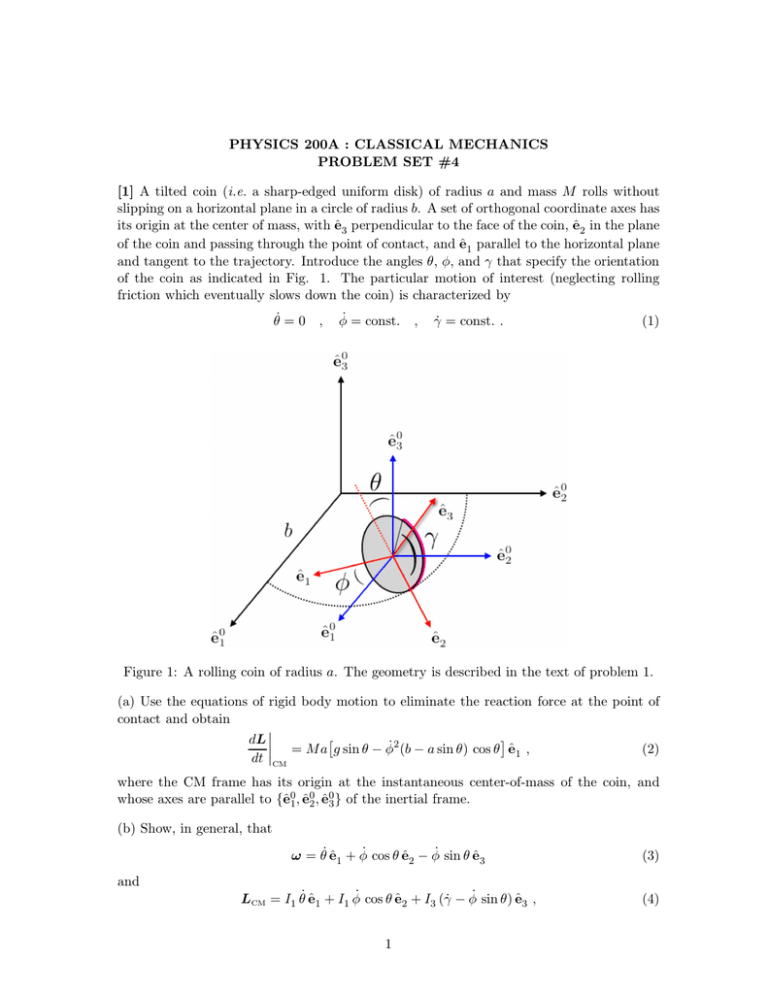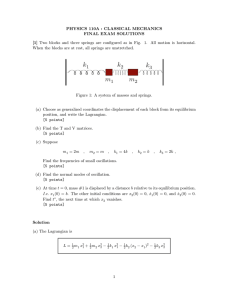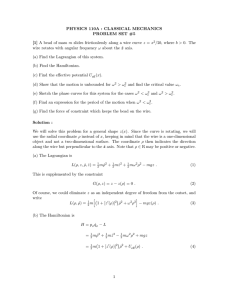PHYSICS 200A : CLASSICAL MECHANICS PROBLEM SET #4
advertisement

PHYSICS 200A : CLASSICAL MECHANICS
PROBLEM SET #4
[1] A tilted coin (i.e. a sharp-edged uniform disk) of radius a and mass M rolls without
slipping on a horizontal plane in a circle of radius b. A set of orthogonal coordinate axes has
its origin at the center of mass, with ê3 perpendicular to the face of the coin, ê2 in the plane
of the coin and passing through the point of contact, and ê1 parallel to the horizontal plane
and tangent to the trajectory. Introduce the angles θ, φ, and γ that specify the orientation
of the coin as indicated in Fig. 1. The particular motion of interest (neglecting rolling
friction which eventually slows down the coin) is characterized by
θ̇ = 0
,
φ̇ = const.
,
γ̇ = const. .
(1)
Figure 1: A rolling coin of radius a. The geometry is described in the text of problem 1.
(a) Use the equations of rigid body motion to eliminate the reaction force at the point of
contact and obtain
dL 2
=
M
a
g
sin
θ
−
φ̇
(b
−
a
sin
θ)
cos
θ
ê1 ,
(2)
dt CM
where the CM frame has its origin at the instantaneous center-of-mass of the coin, and
whose axes are parallel to {ê01 , ê02 , ê03 } of the inertial frame.
(b) Show, in general, that
ω = θ̇ ê1 + φ̇ cos θ ê2 − φ̇ sin θ ê3
(3)
LCM = I1 θ̇ ê1 + I1 φ̇ cos θ ê2 + I3 (γ̇ − φ̇ sin θ) ê3 ,
(4)
and
1
where ω is the instantaneous angular velocity of the body-fixed frame as seen in the CM
frame.
(c) Use the relation between L̇CM and L̇body to show that the period τ for motion around
the circle and the angle of inclination must satisfy the equation
cos θ
τ2
−2
=
φ̇
=
6b
−
5a
sin
θ
.
4π 2
4g sin θ
(5)
Recall that for a disk, I1 = I2 = 14 M a2 , and I3 = 12 M a2 .
NB: This is Fetter and Walecka problem 5.3.
[2] A symmetric top with one fixed point in a gravitational field moves with its symmetry
axis nearly vertical (θ ≪ 1) and pφ = pψ .
(a) Expand the effective potential through terms of order θ 4 .
(b) If p2ψ > 4I1 M gℓ, show that Ueff (θ) has a minimum at θ = 0. Sketch Ueff (θ) for small θ.
Prove that the frequency of small oscillations about this configuration is given by
Ω2 =
p2ψ − 4I1 M gℓ
4I12
.
(6)
(c) If p2ψ is slightly smaller than 4I1 M gℓ, show that Ueff (θ) has a maximum at θ = 0 and
a minimum at some finite value θ ∗ . Find θ ∗ , and sketch Ueff (θ) for small θ, and find the
frequency of small oscillations about θ = θ ∗ .
2






